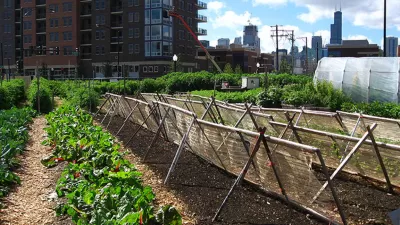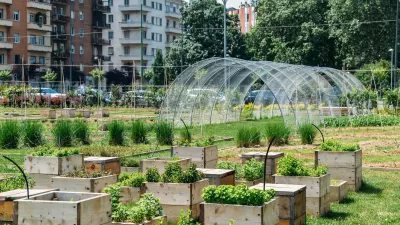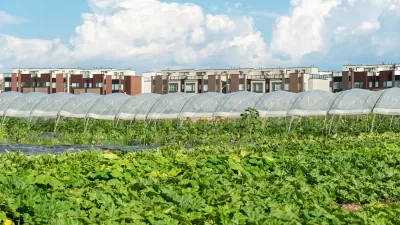Throwing cold water on the latest "techno-optimism" for indoor, urban agriculture.

Joe Cortright writes of his skepticism about urban farming—despite the popularity of "techno-optimistic stories about how a new era of hyper-local food grown in your neighborhood or very nearby." The latest example of which, and the inspiration for Cortright's response, is an article by Adele Peters for Fast Company: "Has This Silicon Valley Startup Finally Nailed the Indoor Farming Model?"
"While the story is replete with VC-pitch based talking points about the efficiency of some aspects of the indoor farming model–purportedly 1 percent as much water use as field crops, 30 miles to the consumer, not 3,000, plus [Plenty] uses LED lights are 64 times more cost-effective than those available a few years ago–one fact is conspicuously missing from the narrative," writes Cortright. That is: "How much will consumers be asked to pay for indoor-grown kale and basil?"
Cortright's concern is with the "dubious" economics of urban agriculture. According to his calculations, urban farming has to 100 times more efficient than conventional farming to cover the cost of land. Instead of a game changer of sustainability, Cortright predicts indoor farming will remain a niche technology for specialized, premium products.
FULL STORY: Dirt cheap.

Alabama: Trump Terminates Settlements for Black Communities Harmed By Raw Sewage
Trump deemed the landmark civil rights agreement “illegal DEI and environmental justice policy.”

Study: Maui’s Plan to Convert Vacation Rentals to Long-Term Housing Could Cause Nearly $1 Billion Economic Loss
The plan would reduce visitor accommodation by 25% resulting in 1,900 jobs lost.

Planetizen Federal Action Tracker
A weekly monitor of how Trump’s orders and actions are impacting planners and planning in America.

Waymo Gets Permission to Map SF’s Market Street
If allowed to operate on the traffic-restricted street, Waymo’s autonomous taxis would have a leg up over ride-hailing competitors — and counter the city’s efforts to grow bike and pedestrian on the thoroughfare.

Parklet Symposium Highlights the Success of Shared Spaces
Parklets got a boost during the Covid-19 pandemic, when the concept was translated to outdoor dining programs that offered restaurants a lifeline during the shutdown.

Federal Homelessness Agency Places Entire Staff on Leave
The U.S. Interagency Council on Homelessness is the only federal agency dedicated to preventing and ending homelessness.
Urban Design for Planners 1: Software Tools
This six-course series explores essential urban design concepts using open source software and equips planners with the tools they need to participate fully in the urban design process.
Planning for Universal Design
Learn the tools for implementing Universal Design in planning regulations.
Caltrans
Smith Gee Studio
Institute for Housing and Urban Development Studies (IHS)
City of Grandview
Harvard GSD Executive Education
Toledo-Lucas County Plan Commissions
Salt Lake City
NYU Wagner Graduate School of Public Service





























